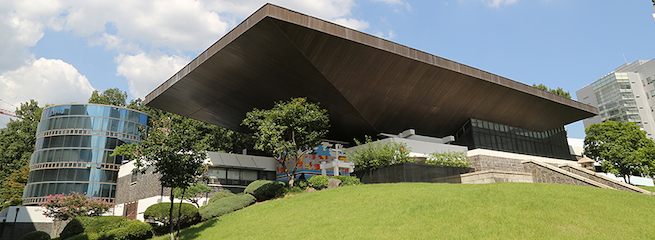
Luce Chapel. A distinctive Christian (Protestant) chapel located on the campus of Yonsei University in Seoul, South Korea. Completed in 1974, it serves as the architectural highlight of Yonsei University Campus and was sponsored by the Henry Luce Foundation. The chapel functions as the spiritual center for the Yonsei University Church, which operates under the university’s chaplaincy program.
Architecture and Design
The design for this building, by architect Kim Seok-Jae, is historically significant as a stylistic hybrid of international style and traditional Korean architecture. The Luce Chapel represents a unique fusion of modernist principles with Korean architectural elements, creating a harmonious integration with its natural surroundings on the university campus. The walkway that leads down the hill from the chapel emphasizes the building’s relationship with the landscape, demonstrating thoughtful site planning.
The chapel’s architectural significance extends beyond its aesthetic appeal, representing an important period in Korean modern architecture where international modernist movements were being adapted to local cultural contexts. This architectural approach reflects the broader mission of Yonsei University as an institution that bridges Eastern and Western educational traditions.
Religious and Educational Function
The Luce Chapel serves as the central worship space for the Yonsei University Church, a faith community of those under the pastoral care of the chaplaincy – professors, staff, students – as well as local residents. The Sunday worship, supported by sacred music led by professors from the School of Music and the choir, is at the heart of various ministries in education, fellowship, missions, and especially campus ministry.
As part of Yonsei University’s Christian heritage, undergraduates are required to attend weekly chapel service for four semesters to qualify for graduation, though it is strictly forbidden by the university code of conduct to discriminate against students from non-Christian backgrounds. The chapel programming includes various worship services and educational activities designed to accommodate the university’s diverse student body.
Campus Integration
The Luce Chapel occupies a central position within the Yonsei University campus in Seoul’s Seodaemun-gu district. The church works in cooperation with the Presbyterian Church and the Methodist Church, founding denominations of Yonsei University while pursuing to become a model church for all churches in Korea. The building serves multiple functions beyond traditional worship, hosting university ceremonies, cultural events, and community gatherings.
The chapel’s location and design reflect Yonsei University’s commitment to integrating spiritual life with academic pursuits. Programs include Sunday Bible Study, Choir, Bible School, Studies for Baptism, Sunday Tea time, age group missionary activities, and summer conferences. This comprehensive programming demonstrates the chapel’s role as both a worship space and a center for community building within the university environment.
Cultural Significance
The Luce Chapel represents an important example of mid-20th century religious architecture in South Korea, demonstrating how Christian institutions adapted international architectural styles to Korean contexts. Its completion in 1974 coincided with a period of significant modernization and Westernization in Korean society, making it a valuable cultural artifact that reflects these historical transformations.
The chapel continues to serve as a landmark within Seoul’s educational landscape, contributing to Yonsei University’s reputation as one of Korea’s most prestigious institutions. Its architectural distinction and religious significance make it a notable example of how educational institutions can successfully integrate spiritual and academic missions through thoughtful architectural design.
Namesake and Heritage
Luce Chapel at Yonsei University was named after Rev. Henry Winters Luce, an American missionary in China in the late 19th century. He was also the father of publisher Henry R. Luce, who founded Time Inc. and established Time magazine.
The chapel was named in his honor because of his significant contribution to Christian missionary work in China. The Henry Luce Foundation was established in 1936 by Henry R. Luce, the co-founder and editor-in-chief of Time Inc., to honor his parents who were missionary educators in China.
Rev. Henry W. Luce’s missionary work in China established a lasting connection between the Luce family and Asia, which is why there are multiple Luce Chapels across Asian universities. The Luce Memorial Chapel at Tunghai University in Taichung, Taiwan, designed by I.M. Pei and named in honor of Harry’s father, Rev. Henry Winters Luce, an American missionary in China in the late 19th century. Luce Chapel at the prestigious Yonsei University in South Koreaare both part of this legacy.
The foundation continues to support educational and cultural initiatives in Asia, reflecting the missionary and educational heritage of the Luce family’s work in the region. This explains why Yonsei University, with its own Christian heritage and educational mission, received support from the Luce Foundation to build the chapel as a center for spiritual and academic life.